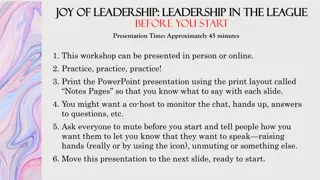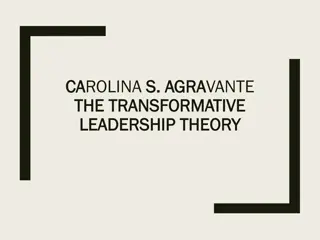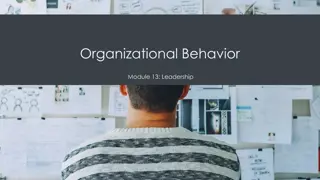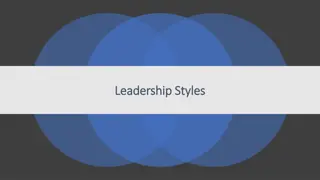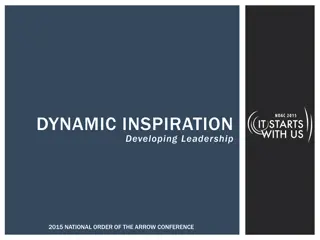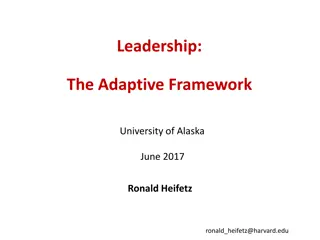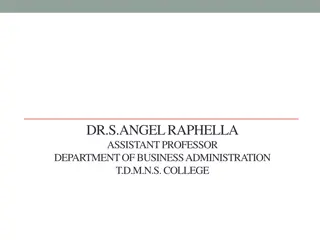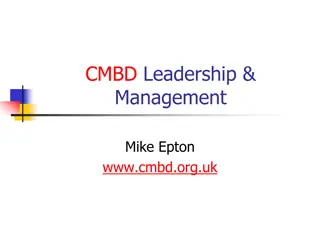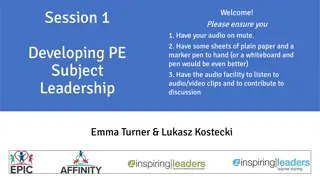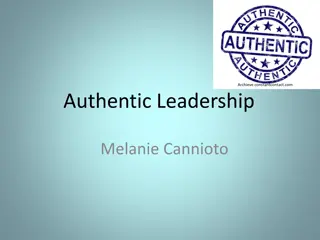Understanding Quiet Leadership and Its Impact in Modern Organizations
Quiet Leadership promotes introverted leadership styles, challenging the extrovert ideal in leadership. It emphasizes a balance between collaborative work and individual reflection, harnessing the strengths of both introverts and extroverts for organizational success. Scientific evidence supports the benefits of diverse personalities in the workplace. Understanding introversion and extraversion as a spectrum helps create environments where individuals can thrive based on their preferences and strengths.
- Quiet Leadership
- Introverted Leadership
- Organizational Success
- Workplace Diversity
- Personality Spectrum
Uploaded on Sep 11, 2024 | 0 Views
Download Presentation

Please find below an Image/Link to download the presentation.
The content on the website is provided AS IS for your information and personal use only. It may not be sold, licensed, or shared on other websites without obtaining consent from the author. Download presentation by click this link. If you encounter any issues during the download, it is possible that the publisher has removed the file from their server.
E N D
Presentation Transcript
What is Quiet Leadership? Quiet Leadership is term that has become associated with a body of work focussed on promoting the benefits introverted leadership styles. Popularised by Susan Cain s 2012 book Quiet: The Power of Introverts in a World Which Can t Stop Talking, it seeks to move away from a model of leadership based on the extravert ideal : the omnipresent belief that the ideal self is gregarious, alpha and comfortable in the spotlight . Instead, it recognises the differences between extraverts and introverts and considers how best individuals, teams and organisations can work in ways which maximise the benefits of both. It asserts that the most successful organisations will be those which use both collaborative and group-based ways of working (to challenge assumptions and form census), whilst allowing individuals the time and space for reflection (to avoid groupthink and organisational inertia). As a result, leadership is seen as not the preserve of extraverts or introverts: it can be loud or quiet and we need to employ elements of both throughout our work. 2
What is the science / evidence? Broadly, between a third and a half of the population self-identify as introverts , at least to some extent. And there is a breadth of empirical evidence that shows that people are hard-wired to respond differently to different levels of stimulation and that these differences can be correlated with physiological and functional differences in the brain which determine how we process stimulation, respond to reward and assess risk. In the workplace, there is a substantive body of research by people such as Hans Eysenck, and Chaiara Haller & Delphine Courvoisier testifying to the fact that this diversity is a good thing: creativity requires a healthy balance of solitude and interpersonal interaction. Essentially, this shows that people are most creative when they are comfortable and that, given that different people feel comfortable in different situations, we need a range of environments in the workplace to get the best from people. Ultimately, this is about recognising how different people respond to stimulation: Introverts get their energy from inside themselves and need solitude to recharge. Whereas extraverts get their energy from interpersonal interaction and recharge by socialising. But it is a spectrum . 3
Character strengths Introversion and extraversion exist on a spectrum: different people have different preferences and different strengths. Extraversion Introversion Ambiversion Prefer less stimulating environments Preference for morestimulating environments Prefer focusing on one task at a time and do so deliberatively Tackle jobs quickly and make quick decisions Think before speaking and listen more than they talk Think out loud and on their feet Feel they express themselves better in writing Prefer talking to listening Recharge by socialising Recharge by being alone 4
Who are Quiet Leaders? Bill Gates, Found of Microsoft: Quiet and bookish, but apparently unfazed by others opinions of him: he s an introvert, but not shy. Mark Zuckerberg, Facebook COO: Shy and introverted and he often does not seem very warm to people who don't know him, but he is warm". Rosa Park, Civil Rights activist: When she died, the flood of obituaries recalled her as soft-spoken, sweet, and small in stature. They said she was timid and shy but had the courage of a lion. They were full of phrases like radical humility and quiet fortitude. Mahatma Gandhi, leader of the Indian independence movement: In a gentle way you can shake the world . Albert Einstein, Physicist: The monotony and solitude of a quiet life stimulates the creative mind . 5
So what? Quiet Leadership matters for the Cities & Local Growth Unit because our diversity and inclusion survey from last autumn and some anecdotal feedback suggests there is a perceived unconscious bias within the team to rewarding extraversion at the expense of introversion. There has therefore been a lot of interest in what the concept might mean for the Unit and how we can make best use of it. So these insights into different personality types prompt a number of questions: How we ensure that we encourage a breadth of leadership styles and don t privilege either extraversion or introversion? How can our teams employ a range of ways of working which enables everyone to have a voice? How can we support both extraverts and introverts to operate in ways which don t come naturally to them? How can we ensure that our workspaces are configured to encourage both group-based and individual working? How can use different ways to reward success that take account that different people like to be recognised in different ways? 6
What does this mean? The big message from all of this is that we should be open-minded to different types of leadership, but acknowledge that sometime we all need to operate in ways which don t come naturally. The unit recognises the benefits of a diverse team and how differing leadership styles is an integral part of this. Information on Quiet Leadership will therefore be: 1. Incorporated into the Unit induction pack 2. Built into the people plan 3. Championed through the Unit s L and D blog It doesn t just stop here. There is also an onus on us as individuals and in our teams to develop awareness and understanding of our own and others personalities and preferences. There are real benefits individually and as a team from knowing your own and each other s personality types, working to our strengths, whilst trying our best to operate outside of our comfort zone. The next slides set out a package of core learning activities you and your team should look to complete by the end of 2017. There is also information on further activity if you are interested in learning more. 7
Individual Learning here RADA RADA provides various courses looking at how individuals can employ different leadership styles through presence and communication. raising self-awareness quiz Watch these videos here Watch Susan Cain s TED Talk Core Learning Additional E-Learning/Resources Additional Face to Face Learning Leadership and Management - managing self here raising self-awareness Leadership and Management - managing self and here on introversion and leadership. TED Talk Women s Leadership: Purpose, Power and Promotion Women s Leadership: Purpose, Power and Promotion Leadership and Management - managing self Leadership and Management - managing self Emotional Intelligence Learn more about Emotional Intelligence Women s Leadership: Purpose, Power and Promotion Take a quiz to find out where you fall on the introvert- extrovert spectrum and think about how you can act out of your comfort zone podcast Do some free e-learning on Leadership and The Whitehall Industry Group also provides the Women s Leadership: Purpose, Power and Promotion course which focuses on giving you an insights into your leadership style and personal strengths. her book online learning modules online learning modules Management - managing self on Civil Service Learning Listen to Susan Cain s podcast and read her book. There are also online learning modules available via the Quiet Leadership Institute which go into detail of different personality types and what these differences mean for the workplace There is also a raising self-awareness course for the SCS focussed on providing feedback on and raising self- awareness of your leadership style. 8
Team Learning Core Learning : Psychometric Learning as a Team These tools can help teams learn about personality types and how they respond to each other in different situations. This develops your own self-awareness while enables teams to work together more effectively and adapt leadership approaches to bring out the best from team members. Team meeting discussion focussed on working practices in the team and how to make the most from different approaches. Someone from the Quiet Leadership group would be happy to attend your team meeting or provide information to help structure this conversation. Additional Team Activity Civil Service Learning There are various different psychometric tools such as Myers Briggs, Belbin and Strengths Deployment Inventory (colours) Quiet Leadership Institute s Quiet Kit Quiet Leadership Institute s Quiet Kit The Quiet Leadership Institute s Quiet Kit , includes agendas and activities for running team meetings, focussed on what individuals have learnt through QLI online learning resources. More information is available via Civil Service Learning (click on tab to the right). 9
5 small practical steps we can all take to get the most out of everyone in the Unit Meetings Send out agenda and papers in good time - this gives people time to prepare and suggest comments to be raised if they do not feel comfortable doing so in the meeting. Make people aware in good time if you would like them to chair/lead on parts of the meeting. Working practices Make best use of the different spaces in our offices that enable us to work in different ways: open plan spaces are great for keeping in touch with people across the Unit but we should also use quiet desks when we need time by ourselves. Keep diaries up to date with working patterns e.g WFH/quiet-desk time people will then know where you are and how best to contact you. Supporting others to act outside of their comfort zone From time to time, we all need to operate in ways which don t come naturally. Line managers in particular can support their staff to step outside of their comfort zones when required and assist them to find the space to recharge and reflect afterwards. 10
Contacts If you want to find out more about quiet leadership or any of the L&D opportunities above, please contact: Kirsty Pearce (kirsty.pearce@beis.gov.uk / 07920 295648) Pete Northover (peter.northover@beis.gov.uk / 07909 932286) Claire Denniss (claire.denniss@beis.gov.uk / 07590 456848) 11



